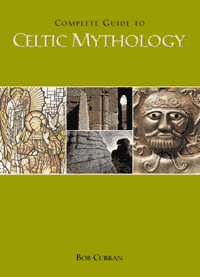 |


|
|||
 Under the floors of several sanctuaries, a wealth of fascinating objects have been found which, it is assumed, were calculated to protect or enhance the sacredness of the place. Buried weapons have been found at several sites in Eastern Europe, suggesting offerings to the god for victory in battle or even for supernatural defence of the sanctuary. Interestingly, at sites like Harlow, the bones of ritually slaughtered animals have been found, from feasts within sanctuary precincts, when a portion of their meat would have been offered to the god. In Eastern Europe, these animal bones are alarmingly mixed with human remains, demonstrating that in parts of the Roman- Celtic world, old practices dating from the time of the Druids had not been entirely forgotten. The dead were frequently believed to be extremely hostile towards the living. It seems likely that the enclosures not only lent sanctity to the ground and air within them but protected the people who lived outside them. In other words, the enclosures were made to restrain spirits which, if allowed, would cause harm to mortals. Where possible, Celtic communities buried their dead on islands so that moving water would protect them from the unquiet spirits. Those who lived away from available islands had to take other measures to protect themselves and one was to segregate the area in which the dead lay. They buried their dead on high hilltops and on mountainsides, well away from the communities of which they had once been a part - and to which they might return. In addition they encircled the burial sites with deep ditches filled with water, thorns and protective objects that the spirits would have to cross to return to the world of the living. It was imagined that the hostile spirit would give up any attack, rather than combat such obstacles. Later, drystone walls were used to encircle burying grounds, both to keep in the ghosts and, from a more practical point of view, to keep out scavenging animals. A number of old folktales from Ireland and Scotland such as Teig O'Kane and the Corpse speak of phantoms that are trapped behind, and cannot cross, an unseen wall of fire that surrounds the graveyard. Not only ancestral ghosts were restrained by such enclosures. There was, in early Celtic belief, a strong veneration for chthonic – underworld – deities. In order to make due offerings, dry wells and holy shafts were sunk into the earth. These created a contact point between an underworld of spirits and the day-to-day world of mortals. Through these connections, the powers of the god could often be manifest, exuding beneficence or malignant powers. If the latter, it was as important to be protected against the powers as to worship them. Consequently restraining walls were raised to limit the extent of the forces that seeped from the votive shafts. In Britain, as in most of the Celtic West, many of these wells or shafts are of Roman date. This does not mean that they were part of Roman religion or that the Romans even used them; it is more probable that they were used by native Celts at the time of the Roman occupation. This assumption is strengthened by the fact that several of the enclosed shafts were tiled and had crow skeletons imbedded in their walls – crows being the symbols of Underworld deities. Healing Springs and Pools From very earliest times there has been a close association between water and healing. It was supposed, according to earliest belief, to wash away both disease and physical afflictions and to purify the skin and body. Under Roman influence, great baths and water-pools were created all through the civilised world, yet even these were associated with rudimentary spirits and forces. One of Christ's miracles was performed at the healing Pool of Beth-said where an angel or spirit ‘ruffled the waters with its wings’ and the first person that entered the pool afterwards was cured of their affliction. The great water-healing shrines of the Celtic world did not fully flourish until the Roman-Celtic period. In Roman Britain and in Gaul there were a number of curative cults who made regular pilgrimages to the great centres at places such as Bath, Lydney and Source des Roches de Chamalières in the hope of being healed. Not all of these sites were temples in the grand style of Bath. Some were merely ornamented pools based around springs or natural clefts through which healing waters ran. Pilgrims flocked to these centres, some bearing wooden or clay representations of themselves in their distressed state believing that the deity would replace these with better models and so cure them In earliest times, there were local spirits or forces that performed healing in return for supplication and worship. Over the years, recognisable deities began to evolve, largely due to classical influences. In northern Britain there were a number of identifiable aquatic deities, the most important being the goddess Coventina who presided over a site near Carrawburgh. Similarly Verbeia was worshipped at the rivers Wharfe and Tees while a number of other water-nymphs were the object of veneration at sites along the Humber. A name that occurs time and again is that of Latis. This might have been a generalised term since it means ‘goddess of the Pool’. Another virtually nameless incarnation of the same goddess may be found at the healing springs at Buxton where the name Aquae Arnemetiae means ‘the waters of the goddess who lived in the sacred grove’ – a concept that united two sacred Celtic sites Water was associated not only with healing. In the Celtic mind it was also associated with fertility and renewed life. After all, water was necessary to make crops grow and to restore vitality to parched earth – and people. Some deities might have combined the attributes of healing and fertility, becoming important entities closely connected to the source and creation of life. Along the River Boyne in Ireland, a number of early Celtic tribes believed that they had sprung from the loins of the river goddess Bóinn. The mating of the supreme god Daghdha and the river-goddess Bóinn (see Spirits of Earth and Air) is symbolic of the union between the fertile land and the river-water that brought about growth and irrigated crops. The marriage between a river-spirit and a tribal god was not uncommon among the Celts. The river ensured the well being, fertility and rejuvenation of land and people. At many sites, such as Bath and Buxton, offerings of money and jewellery are to be found – symbols of hope and requests for good health and well being For the ancient Celts, water was a powerful symbol and the number of water-shrines and sacred pools that flowered during the Roman occupation of Western Europe bears testament to this. Although the major aquatic shrines date from that period, there is no doubt that springs and pools were being enclosed as sacred sites throughout Europe long before the Romans arrived Ground, bog, lake, mountain, grove and pool – all were the embodiment of the landscape as well as the home of the gods. As such they were places of veneration, areas that needed to be ‘sectioned off ’ from the rest of the world. Surely this is the origin of temples and churches even today.
From Complete Guide to Celtic Mythology by Bob Curran |
[ Back to top ]
All Material © 1999-2006 Irelandseye.com and contributors

